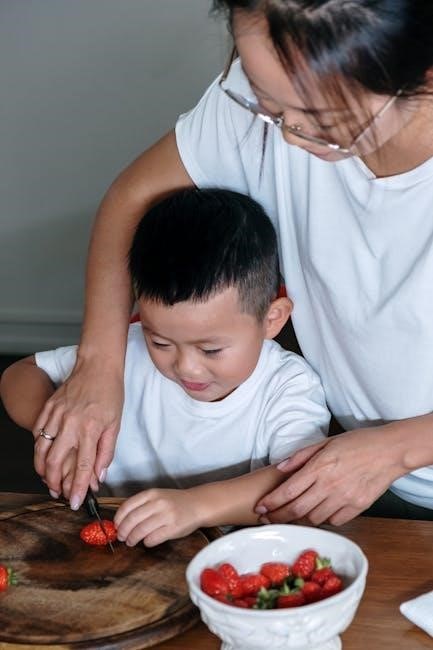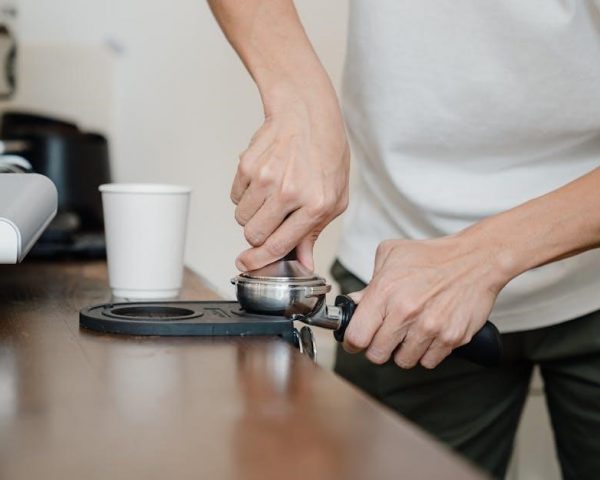Proper care for cutting boards is essential to maintain their durability and hygiene. Regular maintenance prevents damage and ensures food safety. Learn tips to extend longevity and keep your board in great condition.
1.1 Importance of Proper Maintenance
Proper maintenance is crucial for extending the lifespan of your cutting board and ensuring it remains hygienic. Neglecting care can lead to damage, warping, or bacterial growth. Regular cleaning and conditioning prevent cracks and maintain the surface’s integrity. This not only protects your investment but also ensures food safety. A well-maintained cutting board resists odor absorption and stains, keeping it functional and attractive for years. By prioritizing maintenance, you preserve the quality and durability of this essential kitchen tool, making it a lasting addition to your cooking routine.
Cleaning Your Cutting Board
Cleaning your cutting board is vital for hygiene. Use mild dish soap and warm water, then rinse and dry thoroughly. Avoid dishwashers to prevent damage.
2.1 Daily Cleaning Routine
A daily cleaning routine is crucial for maintaining hygiene. After each use, wash the cutting board with mild dish soap and warm water. Scrub all surfaces thoroughly, paying attention to any areas with visible residue. Rinse well to remove soap residue, then dry with a clean towel. For wooden boards, avoid soaking or using harsh chemicals, as this can damage the material. Regular cleaning prevents bacteria buildup and keeps your cutting board in excellent condition for everyday use.
2.2 Deep Cleaning and Sanitizing
For deep cleaning, mix equal parts water and white vinegar. Apply the solution to the cutting board and let it sit for 10 minutes to break down residue. Scrub with a soft brush, then rinse thoroughly. Sanitize by wiping with a solution of 1 tablespoon unscented chlorine bleach in 1 gallon of water or using Clorox wipes. For tough stains, apply a baking soda paste and scrub gently. After sanitizing, dry the board with a clean towel to prevent moisture buildup and bacterial growth.
Wood vs. Plastic Cutting Boards
Wood cutting boards are durable and eco-friendly but require conditioning. Plastic boards are easy to clean and dishwasher-safe but may harbor bacteria over time.
3.1 Material-Specific Care Tips
Wood cutting boards require regular conditioning with food-grade oils to prevent cracking, while plastic boards are dishwasher-safe but should be replaced when worn. For wood, avoid soaking and use mineral oil or beeswax to maintain hydration. Plastic boards are lightweight and easy to sanitize but may harbor bacteria in scratches. Always clean both materials promptly after use, especially after handling raw ingredients, to ensure hygiene and longevity. Using separate boards for meats and vegetables can also prevent cross-contamination and extend their lifespan.

Conditioning Wooden Cutting Boards
Conditioning wooden cutting boards with food-grade oils prevents cracking and extends lifespan. Regularly applying mineral oil or beeswax hydrates the wood and maintains its durability.
4.1 Using Food-Grade Oils and Waxes
Using food-grade oils and waxes is crucial for maintaining wooden cutting boards. Mineral oil and beeswax are popular choices, as they hydrate the wood and prevent cracking. Apply a thin, even layer using a clean cloth, allowing it to absorb fully. Repeat this process regularly to keep the wood moisturized and resistant to water. Avoid using cooking oils, as they can go rancid. Proper conditioning ensures durability and prevents the wood from drying out, keeping your cutting board in excellent condition for years.

Preventing Bacterial Growth
Preventing bacterial growth on cutting boards requires consistent sanitizing, especially after handling raw meat, poultry, or seafood. Use vinegar or hydrogen peroxide for effective disinfection. Regular cleaning and drying are essential to avoid moisture buildup, which can foster bacteria. Proper care ensures a hygienic surface for food preparation, reducing the risk of contamination and maintaining a safe kitchen environment.
5.1 Sanitizing After Raw Meat, Poultry, or Seafood
Sanitizing your cutting board after handling raw meat, poultry, or seafood is crucial to prevent bacterial growth. Use a solution of equal parts water and white vinegar or hydrogen peroxide to disinfect. Scrub thoroughly with a clean brush, then rinse with warm water. Avoid soaking wooden boards, as this can damage the material. For plastic boards, a dishwasher cycle on high heat is effective. Always dry the board completely to prevent moisture buildup, which can harbor bacteria. Regular sanitizing ensures a hygienic surface for food preparation.

Maintenance and Repair
Regular maintenance and timely repairs are key to extending the life of your cutting board. Sand rough spots, oil frequently, and avoid harsh chemicals to maintain its condition.
6.1 Refinishing and Oil Application
Refinishing your cutting board involves sanding to smooth rough surfaces and applying food-grade oils like mineral oil or beeswax. Start by sanding the board to remove scratches or stains. Once smooth, use a clean cloth to apply a generous amount of oil, ensuring even coverage. Let it sit for 30 minutes before buffing with a clean cloth. Regular oil application hydrates the wood, preventing cracks and maintaining its natural beauty. This process not only restores but also protects the board from water damage and bacteria growth.
Storage Tips
Store your cutting board in a dry, secure place to prevent moisture absorption. Use a stand or prop it upright to allow airflow, avoiding humidity exposure.
7.1 Keeping Your Cutting Board Dry and Secure
To maintain your cutting board’s condition, store it in a dry, well-ventilated area. Avoid stacking boards, as this can cause warping or scratches. Use a rack or stand to keep it upright, allowing air to circulate evenly. Never store a damp or wet cutting board, as moisture can lead to bacterial growth or warping. For added protection, place it away from direct sunlight and heat sources. Proper storage ensures your cutting board remains durable, hygienic, and ready for use.
DIY Refinishing Techniques
Restore your cutting board by sanding and applying food-grade oil or wax. This process revives the surface, ensuring it remains smooth, hygienic, and ready for use.

8.1 Steps to Restore Your Cutting Board
Restoring your cutting board involves sanding to remove scratches and imperfections. Start with coarse-grit sandpaper, then switch to fine-grit for a smooth finish. Clean the board thoroughly with mild soap and water. Apply food-grade mineral oil or beeswax to hydrate the wood and protect it from moisture. Avoid harsh chemicals or abrasive cleaners. Let the board dry completely before reuse. Regular maintenance ensures longevity and keeps your cutting board in excellent condition for years to come.
Choosing the Right Cutting Board
Selecting the right cutting board involves considering material, size, and maintenance needs. Opt for durable, easy-to-clean options that suit your kitchen habits and food preparation requirements.
9.1 Considerations for Material, Size, and Maintenance
When selecting a cutting board, consider the material—wood or plastic—based on durability, ease of cleaning, and maintenance needs. Wooden boards require conditioning, while plastic boards are dishwasher-safe. Size matters; choose a board large enough for food preparation but manageable for storage. Maintenance varies: wood needs oiling, while plastic can be sanitized more aggressively. Your lifestyle and cooking habits will guide the best choice for long-term functionality and hygiene.

Common Mistakes to Avoid
Avoid soaking wooden boards in water, using harsh chemicals, or Putting them in the dishwasher. Never neglect conditioning wooden boards or storing them improperly, as this can warp or crack them.
10.1 Dos and Don’ts for Cutting Board Care
Always clean your cutting board with mild soap and warm water, then air-dry it. Regularly condition wooden boards with food-grade oils to prevent cracking. Avoid using harsh chemicals, abrasive scrubbers, or putting wooden boards in the dishwasher. Never soak wooden boards in water for extended periods, as this can cause warping. For plastic boards, avoid high heat and sharp objects that may cause scratches. Store boards in a dry, secure place to maintain their condition and prevent bacterial growth. Following these guidelines ensures your cutting board remains durable and hygienic for years.

Proper cutting board care ensures longevity and hygiene. Regular maintenance, cleaning, and conditioning are key to preserving your board and keeping your kitchen safe and functional.
11.1 Ensuring Longevity and Hygiene
Proper care ensures your cutting board remains durable and hygienic. Regular cleaning, conditioning, and avoiding harsh chemicals prevent damage and bacterial growth. Food-grade oils and waxes maintain wood health, while plastic boards benefit from sanitizing. Storage in a dry place and avoiding soaking prevent warping. By following these steps, you extend the life of your board and keep your kitchen safe and functional for years to come. Consistency is key to preserving both appearance and usability.


